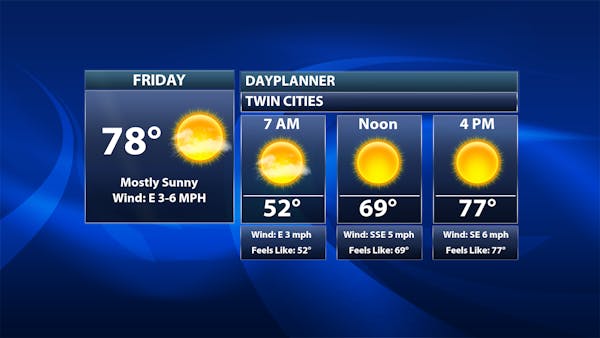Minnesota has ended the summer with significant drought statewide, and, for just the second time in the past two decades, parts of the state fall into the worst-case category of exceptional drought.
A map released by the U.S. Drought Monitor on Thursday showed that the entire state is drier than normal. The two hardest-hit areas include a corridor stretching west from Duluth, encompassing the top of the Mississippi River, and a swath in the southeast corner of the state, with some of the driest land east of Albert Lea.
The Twin Cities remained in the mid-range severe drought category.
"We're not seeing consistent improvement, and that's troubling," State Climatologist Luigi Romolo said. "We don't have a good sense of when this might end."
While this summer has brought a few heat waves as hot as 100 degrees, the real issue is the lack of rain, Romolo said.
Rainfall at Duluth's weather station since the start of May is 5.4 inches less than average, according to the National Weather Service. At the MSP Airport weather station, rainfall since the end of May is 4.5 inches less than usual.
The next opportunity for rain comes Saturday, with possible totals from a tenth to a quarter of an inch across the state, according to Weather Service forecasts. Longer-term forecasts from the Climate Prediction Center are suggesting it will stay dry.
"We're not looking at a big pattern of change towards any consistent rain that would end the drought, for sure," said Josh Sandstrom, a meteorologist with the Weather Service in Duluth.
The prolonged drought started in May and hasn't let up, making for the third summer in a row with dry conditions. Even with last winter's record-setting snowpack, it only takes 6 to 8 weeks without precipitation for parched conditions to set in, Romolo said.
That's led to a requirement that water utilities and others conserve their use in six watersheds across the state, according to the Minnesota Department of Natural Resources' state drought plan.
That area includes roughly the northern half of the Twin Cities. St. Paul Regional Water Services asked its customers on Thursday to start conserving by only watering outside every other day, and only before noon or after 6 p.m.
The lack of water isn't great news for fall color, which will start spreading across the state in the coming weeks.
Many factors affect the annual foliage show, but for the best fall color, trees need to receive enough rain in the spring and summer, said Brian Schwingle, a forest health specialist at the DNR. In the most extreme drought situations, leaves may brown and crumple early in the year, Schwingle said.
Forest health scientists have also observed significant numbers of oaks dying across the state — something Schwingle attributed to several dry growing seasons and the age of the trees.
However, the right mix of sunny, warm days and cool evenings could still help trees produce the anthocyanin pigments that create brilliant reds and purples this autumn, he said.
People around the state can submit their observations online, reports that help to create the drought map every week. Recent ones paint a picture of what's happening on the ground.
"Ponds, creek and marsh on our property are completely dry…water level is down 3-4 feet. Irrigators in nearby fields run constantly," read a Sept. 4 report from north-central Wadena County, an area in extreme drought.
Kaitlyn Root, executive director of the Minnesota State Cattlemen's Association, said all of the state's 16,000-plus producers are in some stage of drought right now. Anxieties about the availability of hay are rising, as cattle are taken off dry pastures.
"These are very hard conditions for our producers, and we're expecting these effects to be felt for years in the cattle industry," she said.
Alan Teich, who raises cattle and grows soybeans outside North Branch in Chisago County, has been farming since he was big enough to help his mother milk cows. He remembers the devastating droughts of 1978 and 1988, and says 2023 ranks up there.
"I got beans that are only six inches tall," he said. "And you'll never be able to combine them."
Chisago County, north of the Twin Cities, sits almost entirely in severe drought. To the north, half of Pine County is in extreme drought, with a sliver of the county in exceptional drought.
Up in North Branch, Teich said he carries insurance on the soybeans, but the funds will not make him whole. The drought has also shriveled up his pasture. He's now keeping his 70 cattle locked in a yard.
"We'll have to buy more hay by wintertime," he said. "We're in the worst of it right now."

Wolves vs. Nuggets series updates: Times for first four games set
Medical examiner identifies pedestrian hit by vehicle and killed in Bloomington
Souhan: A sausage? A knee surgery? Minnesota sports has gone mad

